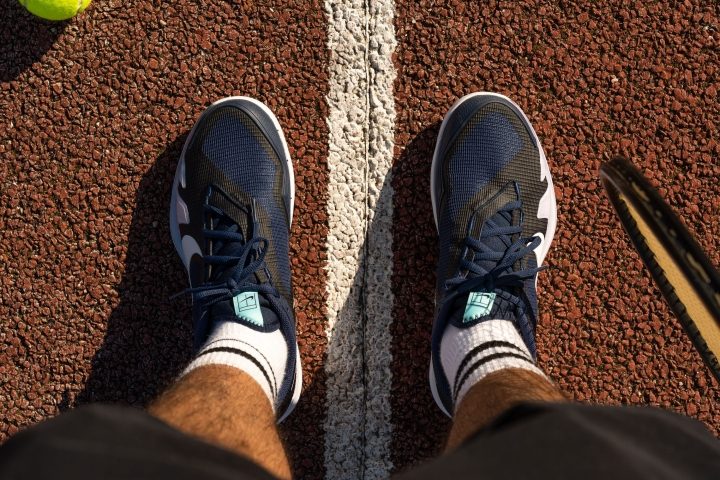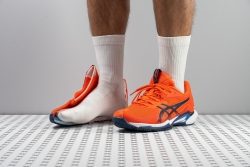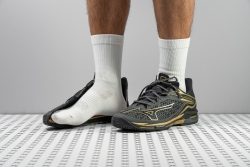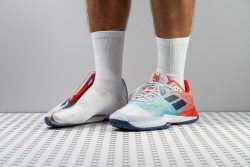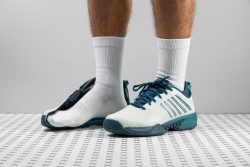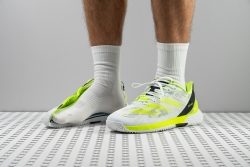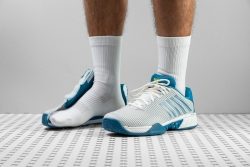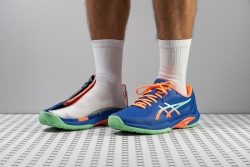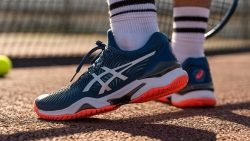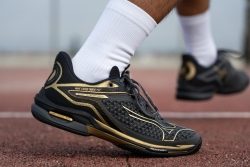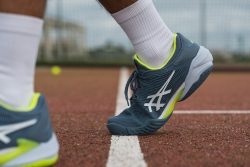7 Best Lightweight Tennis Shoes in 2025
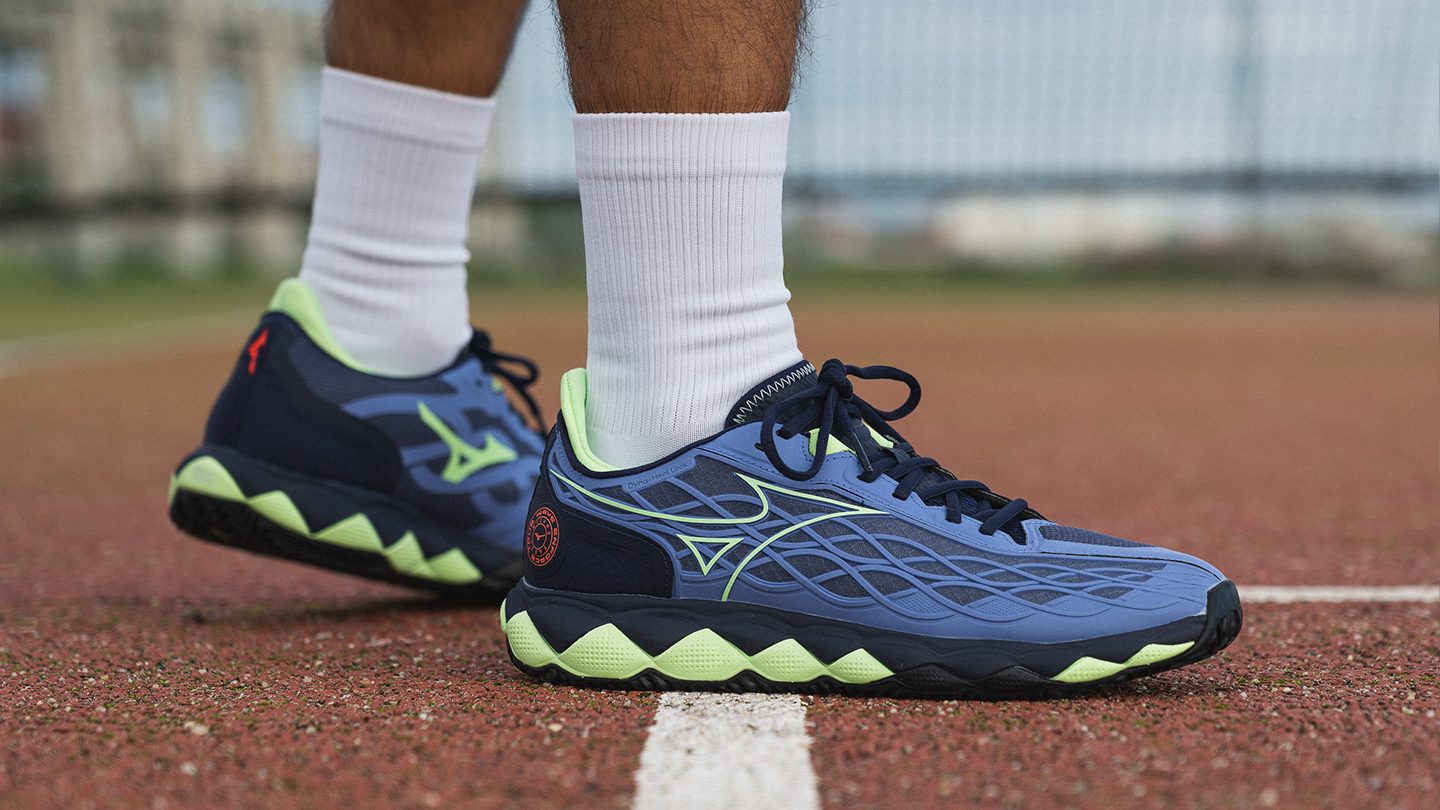
We buy shoes ourselves. We earn commissions when you buy through us, at no extra cost. Why trust us
Step up your game with any of these best-rated lightweight tennis shoes. We are a team of experts who scrutinize airy shoes and put together an impressive list of the best kicks that weigh less than 400g or 14.1 oz. These pairs are an excellent choice for players who are inclined to play aggressively on the court.
Known for top-notch quality footwear, giant brands like K-Swiss, Adidas, Asics, Head, and Wilson offer their latest high-performance shoes that enhance the agility and flexibility of players. They understandably come with minimal design and cutting-edge synthetic materials.
You have plenty of amazing options to select from. To help you narrow down the top choices, we’ve tested, reviewed, and higlighted top picks among these shoes for faster browsing.
How we test lightweight tennis shoes
From mesh and synthetic to knit or even leather shoes, we’ve vetted and double-checked every essential part of the shoes in the RunRepeat shoe testing lab. We’ve also done countless playtests on the clay and hard court to assess the comfort and performance of the shoes.
To publish our comprehensive reviews, we do these steps:
- We procure all the lightweight tennis kicks from a wide array of brands in the market. We invest our own funds to preserve the independence and impartiality of our rankings and reviews.
- We play tennis in these shoes to evaluate each model. We carefully scrutinize each one based on various parameters such as weight, break-in period, energy return, outsole traction, breathability, lateral support, and more.
- We pay special attention to the grip on different surfaces and lateral stability.
- We then put our goggles on and be all geeky about the shoes. We perform another series of tests, but this time, inside our lab, where we cut the shoes open and unearth all the technologies and simple details that make up the shoes.
Best lightweight tennis shoes overall
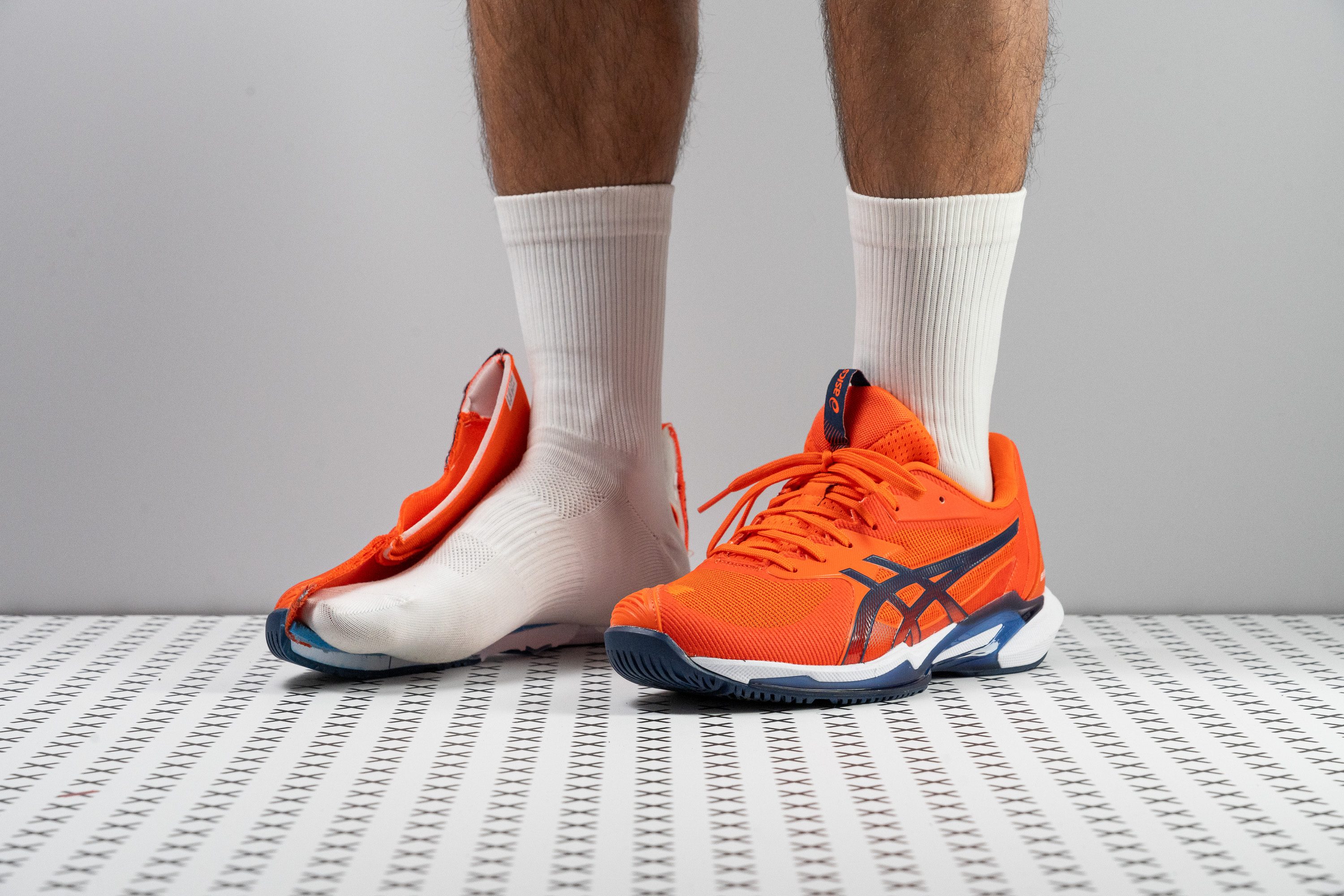













































What makes it the best?
Among lightweight tennis shoes we playtested, ASICS Solution Speed FF 3 dominates the game with its unmatched speed. Our lab reveals it balances the extremes well: staying flexible while stable, grippy while durable, and breathable while protective. It amazed us on and off the court, allowing us to stay in the groove as we played the sport.
Once on foot, the shoe virtually disappears, weighing just 10.9 oz (309g), ensuring freedom of movement and effortless adjustments during play. Other than its lightness, the cushioning keeps us closely connected to the ground and launches us energetically. Maintaining our momentum feels effortless because of the maneuverable midsole that emerged 14.6% more flexible than average in our bend test. The Speedtruss technology adds stiffness torsionally to boost our stability and confidence.
The unwavering traction also keeps our footwork smooth and controlled. The Precision Sole’s pattern allowed us to stop, pivot, and slide as needed. The AHAR PLUS rubber maintains grip without sacrificing durability, and even the upper mirrors this by blending resistance to friction and breathability well. While greatly resisting our Dremel with a perfect score, the open mesh fabric mind-blowingly gets a flawless 5/5 rating for ventilation, keeping us cool throughout our sessions.
However, while the shoe is stable for most movements, it’s not enough for aggressive lateral movements. Baseline players should look for more supportive shoes.
Pros
- One of the lightest tennis shoes on the market
- Fantastic wear resistance and durability
- Exceptionally breathable for a tennis shoe
- Grounded platform with a great court feel
- Rockered heel makes transitions faster and smoother
- Solid stability for a speed-oriented shoe
- Perfect grip with enough give
Cons
- Not for wide feet
- Not very stable for baseline players
Lightweight tennis shoes with the best durability
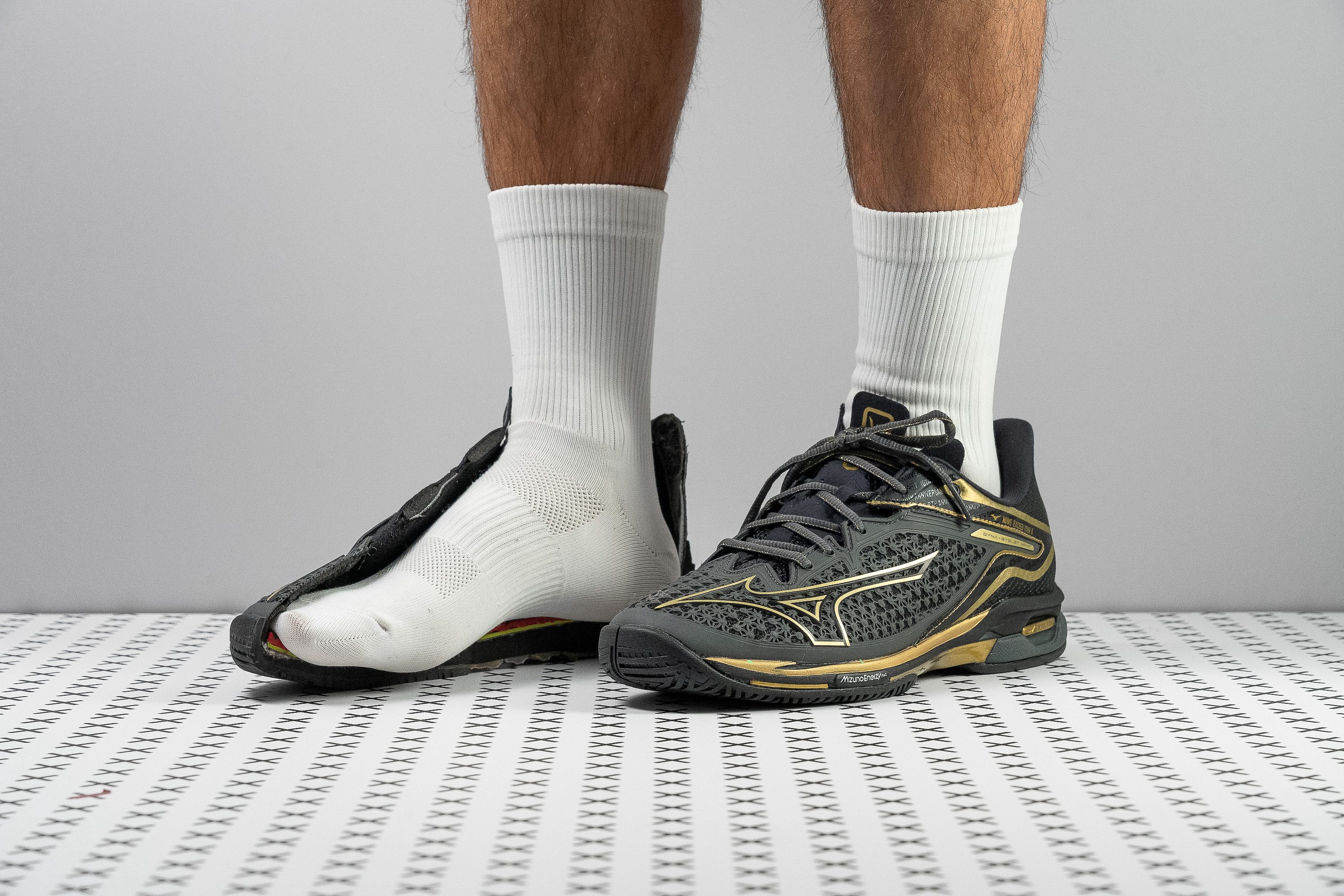


















































What makes it the best?
The Mizuno Wave Exceed Tour 6 exceeded our expectations and impressed us with its energy return and maneuverability on the court. Our lab measurements prove its lightness and even reveal its high resistance to wear, making it our best durable lightweight tennis shoe.
The upper is ready to take on the friction of slides and toe drags as it looked almost untouched after our Dremel test, receiving a 4/5 toebox durability mark. Moving to the outsole, we measured the DuRubber compound to be a tougher-than-average 87.6 HC, a telling sign of its longevity.
Our feet moved instantly with our minds, from crossover steps to quick accelerations. Our scales reveal it's only 11.7 oz (332g), 8.8% below the average tennis shoe. We were sure of each move since the shoe was supportive due to the Wave plate, but the D-Flex Groove in the midsole allowed us to bend freely, boosting our agility.
Amazingly, this pair manages to keep its weight low while packing two foams in its 30.2 mm heel. The main cushioning is the highly responsive Enerzy NXT, which was undeniable during our playtests, and the PoWnCe cushioning in the heel is for impact protection.
Because of the upper’s focus on durability, it lacks ventilation holes for the summer heat, receiving only 2/5 in our lab test. Those who prefer a breathable experience should try searching elsewhere.
Pros
- Lighter than average speedy
- Bouncy and responsive cushioning
- Very stable for a lightweight shoe
- Unusually flexible
- Secure midfoot lockdown
- Perfect grip on hard court
- Excellent overall durability
Cons
- Not very breathable
- Toe drag guard is not very sturdy
- Laces bite when cinched tightly (or when a runner's knot)
Lightweight tennis shoes with the best stability
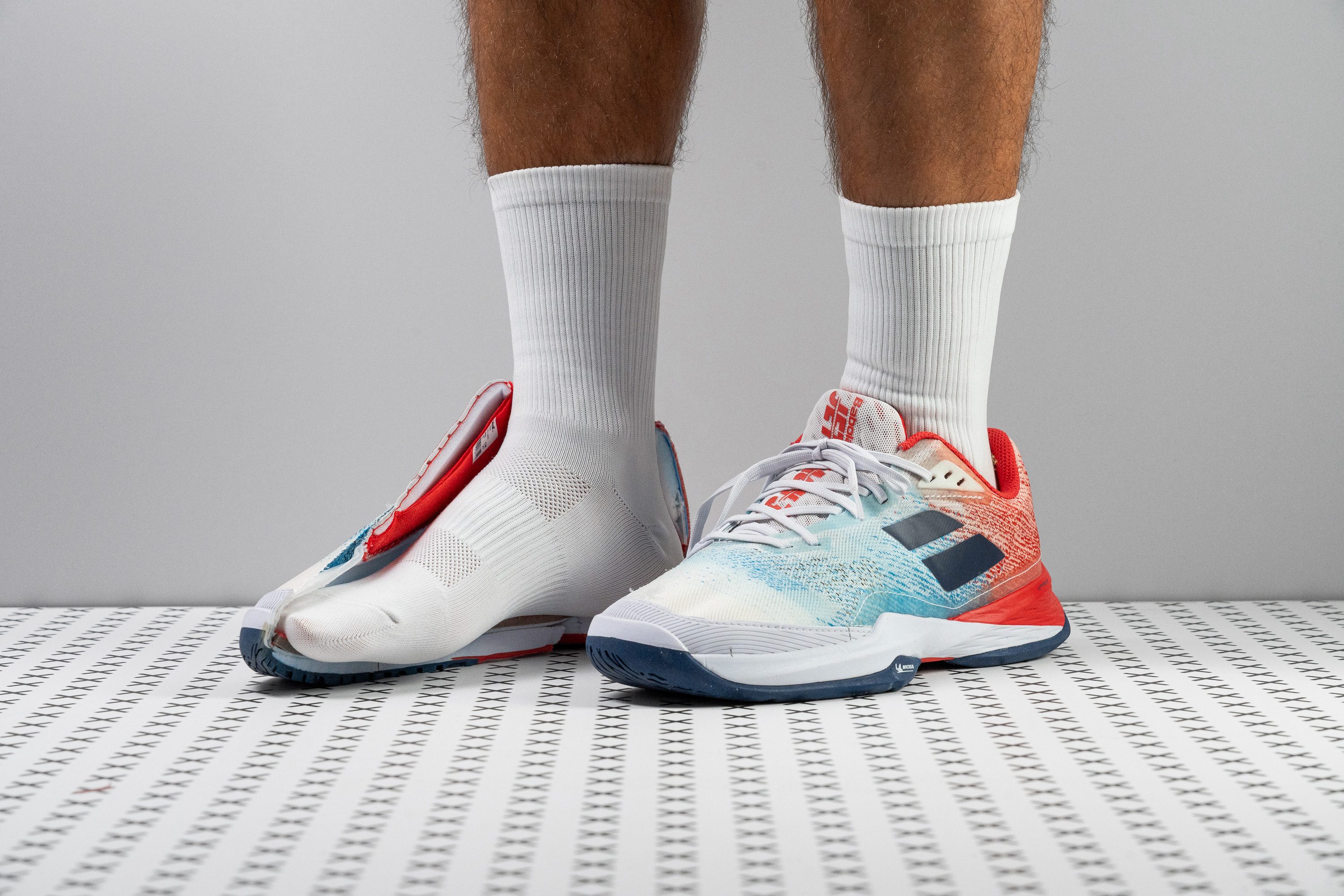

























































What makes it the best?
During our playtests, the Babolat Jet Mach 3 empowered us with the confidence to accelerate and change direction without hesitation. True to its moniker, its extraordinary lightness and agility deliver jet-like speed. Tying the experience together were its solid traction and secure feel, making it our best stability lightweight tennis shoe in the lab.
Wearing the JM3s made us highly aware of the ground with its modest 28.3/18.2 mm stack. Its firm feel naturally enhances our surefootedness. Our sliced shoe reveals most of the midsole is made of a firm 29.6 HA foam, while the heel has a softer 26.5 HA foam for gentler landings.
Meanwhile, the stiff TPU shank makes the midsole highly supportive for sudden lateral movements. Our manual assessment shows a torsional rigidity of 4/5, making it impossible to twist our feet. Boosting our control is the grippy outsole, which also slides easily when needed.
In addition to its reliable stability, JM3 has the weightlessness and flexibility for split-second accelerations. At just 11.0 oz (312g), it’s one of the lightest we’ve tested, 14.3% below average. Its versatility enhances its effortless feel, while its flex grooves make it the most flexible tennis shoe we’ve tried, requiring 37.5% less force to bend.
However, its agility sacrificed impact protection. Our legs felt more tired than usual after our sessions. Those who prefer more cushioning should try other alternatives.
Pros
- Ultra lightweight for a tennis shoe
- Fantastic stability for a speed shoe
- Great grip for intense movements
- Very secure lockdown and foothold
- Breathable for summer sessions
- Feels well-connected to the court
- Highly flexible forefoot
- Comfortable in-shoe feel (ergonomic insole)
Cons
- Falls short of durability (for the price)
- Not a lot of cushioning
- Snug toebox fit (but available in wide)
Lightweight tennis shoes with the best comfort
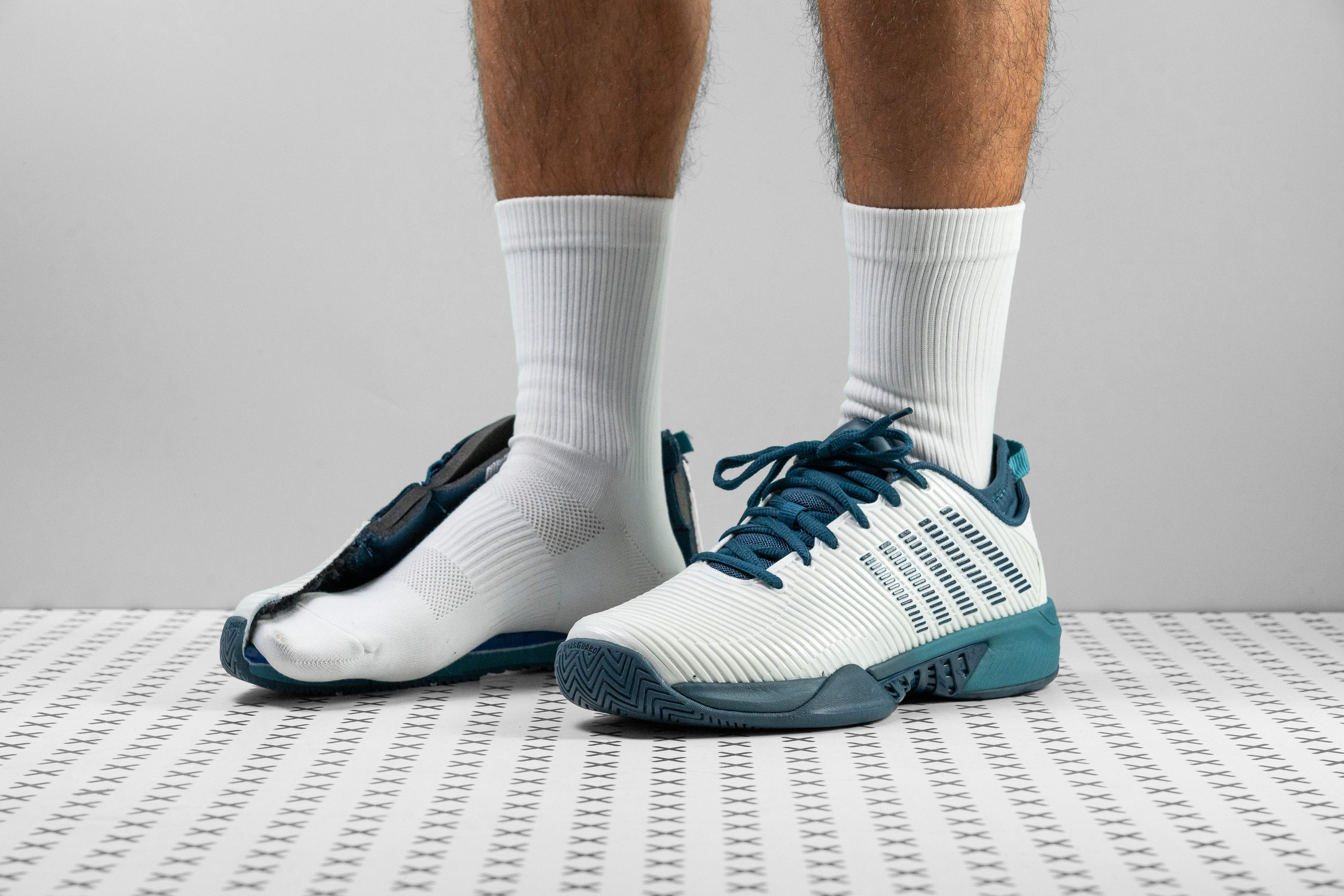















































What makes it the best?
K-Swiss Hypercourt Supreme is a featherweight tennis shoe that transported us to nirvana because of its offered in-shoe comfort. Non-dragging, lots of padding, and feels one with the foot – this is what the Hypercourt Supreme is all about which is why it has the best comfort out there.
Our weighing scale registered 12.31 oz (349g) when we set K-Swiss Hypercourt Supreme on it. It is not only lighter than the average tennis shoe by 2.2% but it also truly feels airy. This shoe also boasts generous padding which embraces our feet in pleasure. The tongue, specifically, measures 10.4 mm in thickness, 26.8% thicker than average.
We also loved how the collar of the K-Swiss Hypercourt Supreme comfortably contoured our ankles as it resulted in a more natural feel whenever we moved. This was substantiated in our lab test where we evaluated the firmness of the heel counter by hand. We rated it 2/5 in rigidness as it effortlessly succumbed to our pressing and pinching.
However, we didn’t get much ventilation in the K-Swiss Hypercourt Supreme. Our microscope evinced this as it displayed closely woven fabric placed between overlays without much perforations. We suggest opting for a more breathable pair if you want to avoid sweaty feet at all cost.
Pros
- Nimble and lighter than average
- Grounded feel underfoot
- Outstanding durability
- Very wide platform
- Soft bootie molds to the ankle
- Excellent balance of grip and give
- Flexible yet propulsive
Cons
- Not very breathable
- Not for narrow feet (upper stretches)
- Not so supportive
Lightweight tennis shoes with the best shock absorption
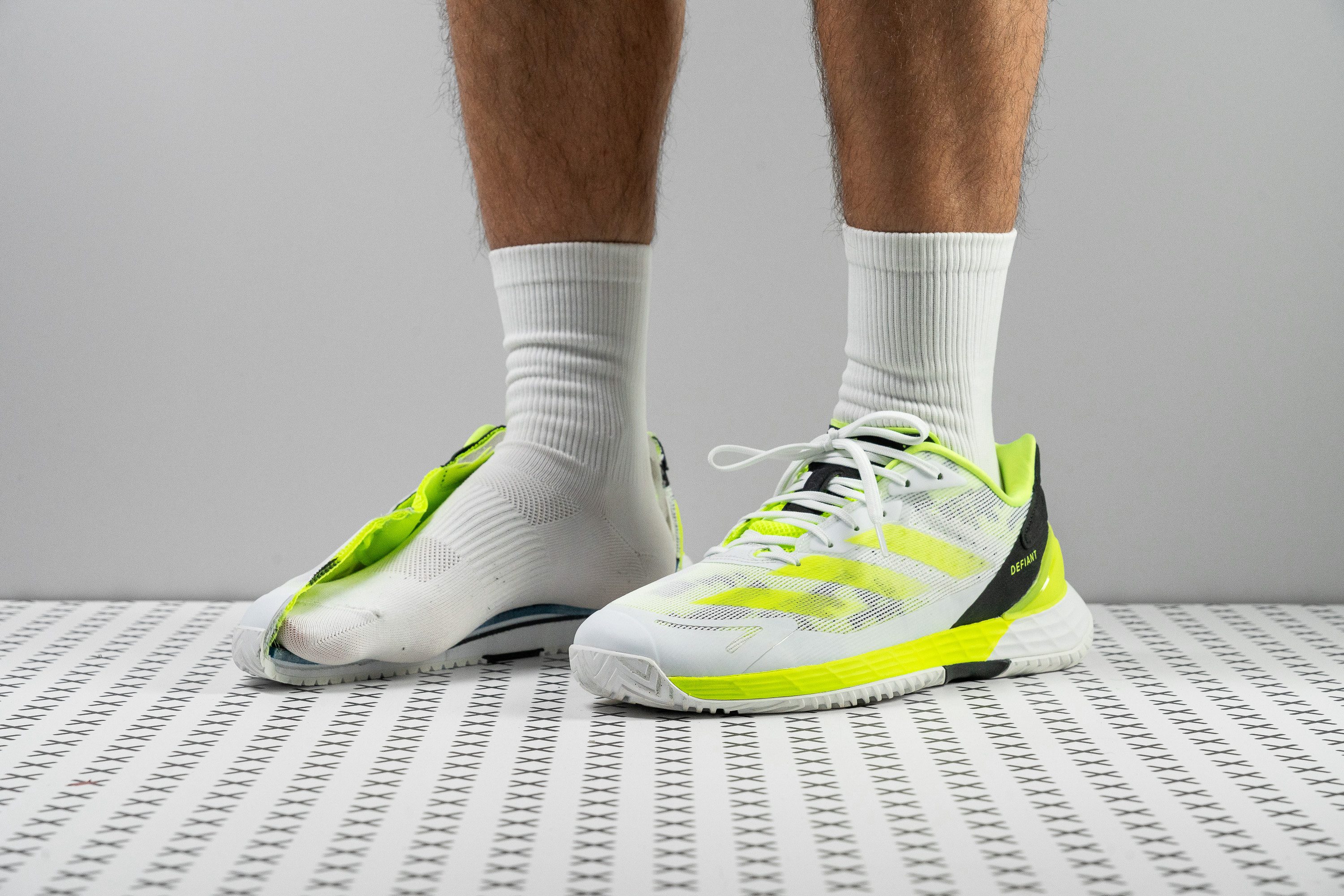










































What makes it the best?
We brought the Adidas Defiant Speed 2 to the courts and in the lab, and based on the results, we are confident it has the best shock absorption among all the lightweight tennis shoes that we tried. It has a playful yet stable sensation that we enjoyed, but we appreciated how it takes good care of our joints with its low-impact stack.
We have a standardized test to measure shock absorption, and Defiant Speed 2 impressed us with its 105 SA score, meaning it's able to reduce the load of harsh landings by 6.1% compared to average. This was a pleasant surprise considering the shoe’s lower 28.8/17.0 mm stack.
Its minimal platform enhances both lightness and flexibility. Our scales show it’s only 12.2 oz (347g) and feels even lighter because of its bendable midsole. Our flex test confirms it needs 17.9% less force to reach 30 degrees, making it easier to maneuver during quick footwork.
A rigid shank is also embedded in the midsole to enhance stability, which we couldn’t deny during our games. This led to a shoe that’s hard to twist, validated by its solid 4/5 torsional rigidity score.
The shoe’s collar design has some awkward extra space and feels a bit slippery, making it tricky to achieve a secure fit. Those who find this a hassle should try the shoe on before purchasing.
Pros
- Grounded platform with good court feel
- Stable base for a speed shoe
- Generously padded insole
- Fairly flexible forefoot
- Impressive durability for the money
- Great balance of grip and give
Cons
- Not everyone can achieve a secure lockdown (especially skinny feet)
- Higher drop may cause toe jamming
Best lightweight tennis shoes for wide feet
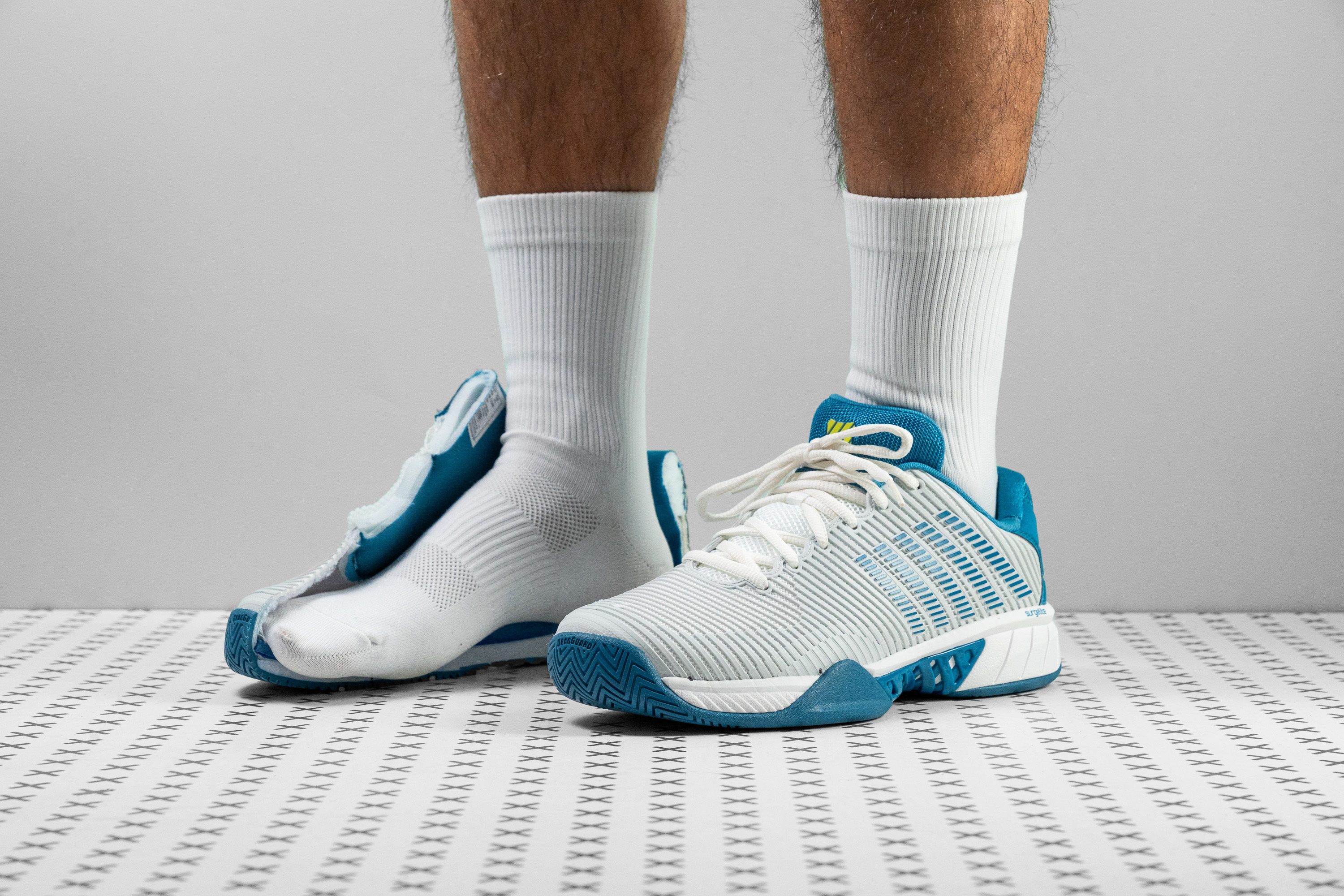













































What makes it the best?
Sporting the K-Swiss Hypercourt Express 2 allowed us to be quick on our feet while remaining comfortable and surefooted thanks to its forgiving fit and stable ride. Our lab results confirm it’s easy to wear for long hours with its lightness and spacious fit, making it our top lightweight tennis shoe for wide feet.
Our toes could freely move and the wide 104.1 mm toebox gave us more control over our quick direction changes. We also measured the midsole to be a wider-than-average 116.4/91.0 mm, which explains why we felt so stable throughout our games no matter how fast we were.
Our sliced midsole reveals a stiff midsole shank that stabilizes us, evidenced by its 4/5 rating in our torsional rigidity test. Even longitudinally, Hypercourt Express 2 emerged 22.0% stiffer than average. While this lessens the natural feel, it aids in a more responsive ride.
Our agility on the court can be attributed to the shoe’s light 12.3 oz (349g) build. Meanwhile, we’re supported by a firm rubber underfoot that allows us to slide and brake as needed. We had no incidents of unwanted slips during testing.
However, the upper traps the heat in and only allows the cool air to enter the midfoot area. To avoid toes drenched in sweat, we cannot recommend this pair for hot and humid weather.
Pros
- Light and nimble on the feet
- Mind-blowing durability for the price
- Well-balanced soft cushioning
- Wide and stable platform for a speed shoe
- Excellent grip and give
- Amazing in-shoe comfort
- Ideal for wide feet
Cons
- Lacks breathability
- Not for narrow feet
Lightweight tennis shoes with the best value for money
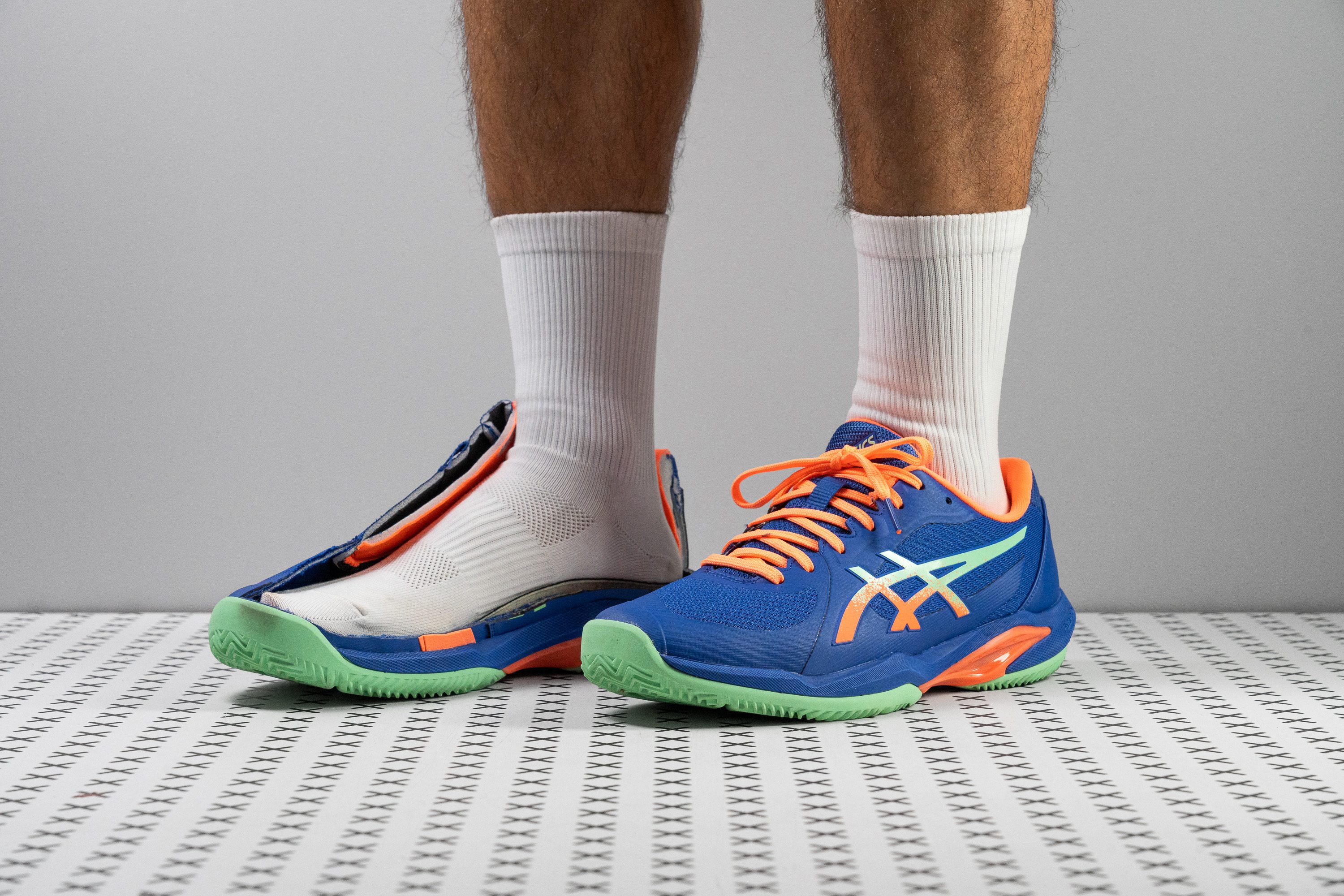












































What makes it the best?
Maximum speed and stability in a minimal package is what the ASICS Solution Swift FF 2 provides in our games. With our lab results mirroring the agility and security we experienced, it’s our best value lightweight tennis shoe, retailing for only $110 compared to the $136 average tennis shoe in our roster.
The shoe’s effortless feel boosted its maneuverability. It promotes swift footwork, with its light 10.7 oz (302g) build following us smoothly. Compared to the average, we measured it to be 16.6% lighter, allowing us to sustain long hours of playing.
We didn’t have to think twice when chasing the ball because we felt heavily supported. We discovered the TRUSSTIC support, which enhances controlled lateral movements and ankle support. From aggressive cuts to quick direction changes, our feet remain well-planted thanks to the shoe’s stiff heel counter (5/5) and high resistance to twisting (5/5).
Thankfully, the firm stability doesn’t sacrifice the shoe’s bendability. Our flex test verifies it’s 7.3% more pliable than average, boosting its nimble nature for chasing the ball all around the court.
However, the upper has weak airflow, making our feet overheat during hot days. If breathability is a must, we suggest going for another pair.
Pros
- One of the lightest tennis shoes
- Fantastic value for money
- Great cushioning-per-gram ratio
- Very agile and maneuverable
- Outsole grips and slides easily
- Impressible midfoot and heel support
- Excellent durability for the price
- True to size and width
Cons
- Very low energy return
- Lacks breathability
Best lightweight tennis shoes
When playing tennis, being light on your feet is a crucial element of your game. In terms of footwear, the quest for the right balance in comfort, support, and agility often leads to a crucial factor: weight.
In this guide we’ll explore what makes lightweight tennis shoes the go-to choice for many players, including a focus on the essential features that set the best lightweight tennis shoes apart. Because an informed player means a smart player, and that might just be your advantage in the game.
6 types of tennis players that love lightweight tennis shoes
- The prodigy: There are plenty of young talents coming through with the world at their feet. But they don’t want to be held back by a pair of heavy and clunky tennis shoes.
- The enthusiast: Whether it's a scorching summer day or a chilly winter morning, this dedicated soul never misses their tennis sessions, and lightweight shoes help keep them agile.
- The strategist: Known for their on-court smarts and impeccable court coverage, this player prefers lightweight shoes as it allows them to react to every volley and chase down every ball that goes down the line.
- The weekend warrior: In between hectic work and family life, this player depends on their lightweight tennis shoes to get them through their Saturday morning club match because as much as they enjoy their tennis, the weekend is full of many more activities to embrace as well.
- The seasoned senior: Age is just a number for this seasoned player who chooses lightweight tennis shoes to maintain their agility and outsmart opponents with experience.
- The coach: Coaches spend hours on the court, acting as a hitting partner and demonstrating techniques with their tennis proteges. Lightweight tennis shoes provide the comfort and speed needed to keep up with aspiring players.

And 5 types of players who prefer heavier tennis shoes
Sure this article might be about lightweight tennis shoes but it would be remiss not to mention that lightweight shoes don’t suit everybody, particularly these types of players:
- The stable mate: These players value the added weight of tennis shoes for the increased stability it provides. Particularly effective for players who aren’t skinny lightweights themselves, heavier shoes can help keep you anchored to the court reducing the likelihood of unnecessary post-match soreness and even injury.
- The shock absorber: Sometimes the additional cushioning and shock absorbing layers that manufacturers create their shoes with comes at the expense of a heavier shoe, and for players who prioritize these comfortable features - particularly on hard courts - might shy away from a lightweight tennis shoe.
- The durability devotee: Heavy shoes have been traditionally associated with durability, or ‘heavy duty’ if you will. While the technology is improving to make this durability lighter, there are plenty of players to this day who will err on the side of sturdy in the pursuit of longer-lasting shoes.
- The all-weather warrior: The reality for most local club-level tennis players is that, unlike what we often see on TV, outdoor playing means all conditions. From wet to cold to windy, and sometimes all three. Some players will lean towards heavier shoes with the theory that they will be better in poor conditions, for example by holding better traction than their lighter weight counterparts.
- The baseline bomber: Players with a baseline-dominant playing style, known for powerful groundstrokes, may opt for heavier shoes to support their aggressive movements and provide a stable base for generating maximum power.
The role that playing styles have on lightweight shoes
Considering weight is an important part of the process in researching and ultimately finding the perfect pair of tennis shoes. However, it’s not just the product to consider, it’s also your playing style. Different players look for different attributes in a shoe so that it suits them the best, not just because that’s what the marketing material told them.
The aggressive baseliner
Those players that find themselves rallying from the baseline will rely on endurance, agility and quick lateral movements. Although there may be some hesitancy for a baseline player to seek out lightweight shoes, they can be beneficial as it allows them to make fast directional changes while still allowing for recovery in between movements, thereby maintaining the endurance required for long matches.
The all-courter
The ability to adapt to different situations and surfaces is a tennis trait frequently sought after, yet infrequently found. However if this is you then you’ll find yourself seeking a balance between lightweight shoes (great for fast reactions on hard courts) and heavier weight shoes (best suited to clay courts as they provide the stability required for sliding across the court).
The serve-and-volleyer
If you find yourself at the net frequently, whether playing doubles or singles, you’ll be looking at prioritizing stability and support in your tennis shoes. Sometimes heavier tennis shoes can provide more support allowing you to stay grounded and ready to clip that volley over the net.
The counterpuncher
Counterpunchers have a unique ability to turn their opponent’s power against them. Although known as being constantly in defense, their style - when done effectively - is one that puts their opponent on the backfoot regardless of how offensive they were playing.
For counterpunchers quick and nimble movements are a regular feature of their game, and as they gradually wear down their competition they find themselves requiring a somewhat unusual combination of responsiveness for fast movements and cushioning for long, drawn out matches.
Counterpunchers definitely benefit from lightweight tennis shoes as they turn their match from ‘counterpunch’ at the beginning, to ‘punchy’ at the end.
Anatomy of a lightweight tennis shoe
Understanding where the engineers concentrate their efforts in trying to make lightweight and reliable tennis shoes is an important part of your research. This will help you know what to look for and what’s important to you. Let’s drill down on those considerations:
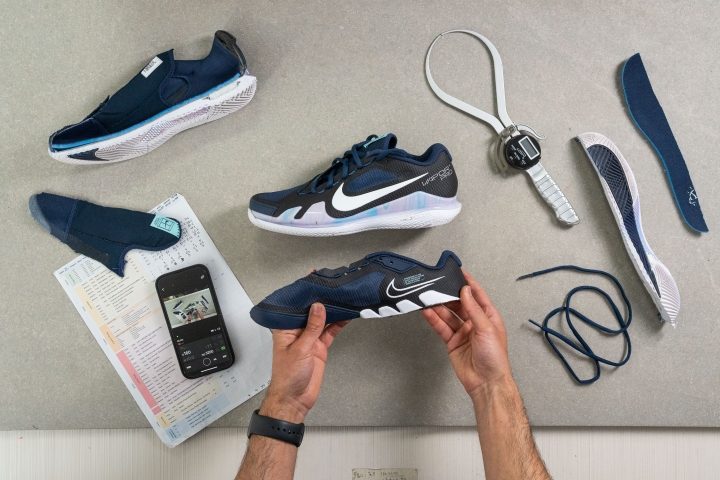
Midsole cushioning
The midsole is crucial for comfort and support, and these technologies offer lightweight yet effective solutions. Brands like Nike use Air Zoom and Asics has its own GEL technology in the midsole to provide responsive cushioning and shock absorption.'
We measure the shock absorption and energy return following the ASTM F1976 protocol.
Outsole traction
Outsoles are often made with durable rubber compounds like Adidas' Adiwear, designed to provide excellent grip and durability on the court. The pattern and composition of the outsole play a significant role in enhancing traction during quick movements.
We measure the friction coefficient (CoF) of each tennis shoe following the SATRA TM144 method.
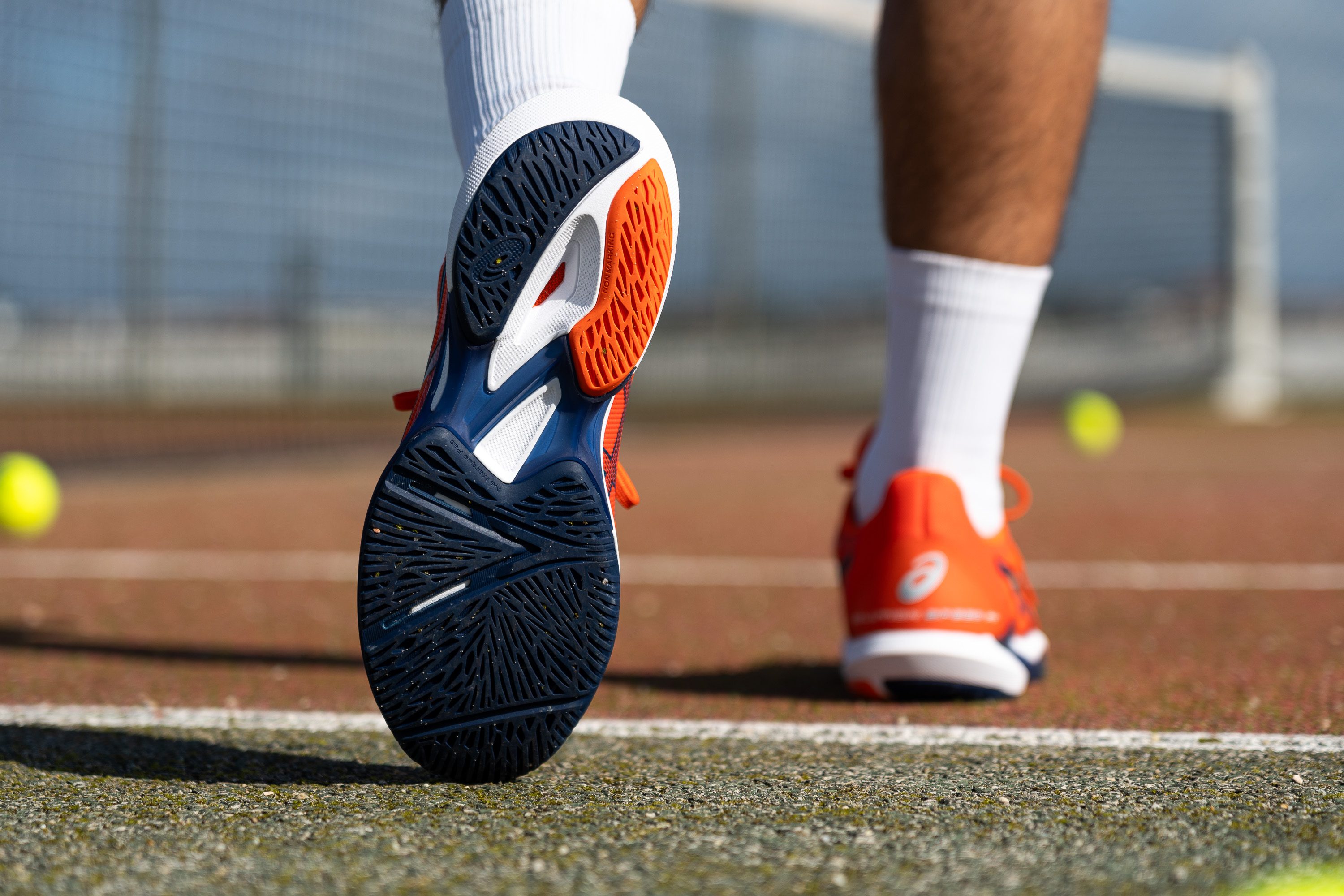
Upper materials
The upper material impacts the shoe's overall weight, flexibility, and comfort.
Synthetic overlays and closely woven fabrics create the sense of stability while retaining durability, allowing the shoes to retain their integrity during all sorts of sharp tennis movements and throughout long rallies.
Toe drag guard
Many of the big tennis footwear brands are using technologies to reinforce the toe cap area to resist abrasion and extend the shoe's life. This is especially important for players who have an aggressive playing style, with fast and sharp court movements to and from the net, plus laterally across the court.
We use a Dremel with a sandpaper tip to test the abrasion resistance of toe drag guards.
Lateral stability
Many modern tennis shoes use a lightweight lateral stability technology designed to provide on-court stability. An example of this is Asics with their Twistruss system, as used on the ASICS Solution Speed FF 2. This is particularly suitable for the player who starts at the baseline but typically moves to the net and requires a fast, flexible and lightweight shoe.
Torsional rigidity
Tennis shoes need to provide torsional rigidity, meaning they resist twisting, to support quick lateral movements.
Some brands integrate shanks or arch support technologies to enhance this rigidity without compromising weight. And shoe engineers know that they can play with this feature, as this recent study published in the European Journal of Sport Science found that “shoe torsional stiffness had no effect on running velocity, on stance duration and maximal values of ground reaction forces” [1], therefore allowing some slack with how shoes can be designed for torsion.
Creative engineering
Wherever the shoe has material is an opportunity for an engineer to create technological improvements, including weight reduction. Expect to see this improve in the coming years with fabrics that demonstrate unbeatable comfort and durability, but still being incredibly lightweight.
